Class Spotlight: Comics: Graphic Journalism
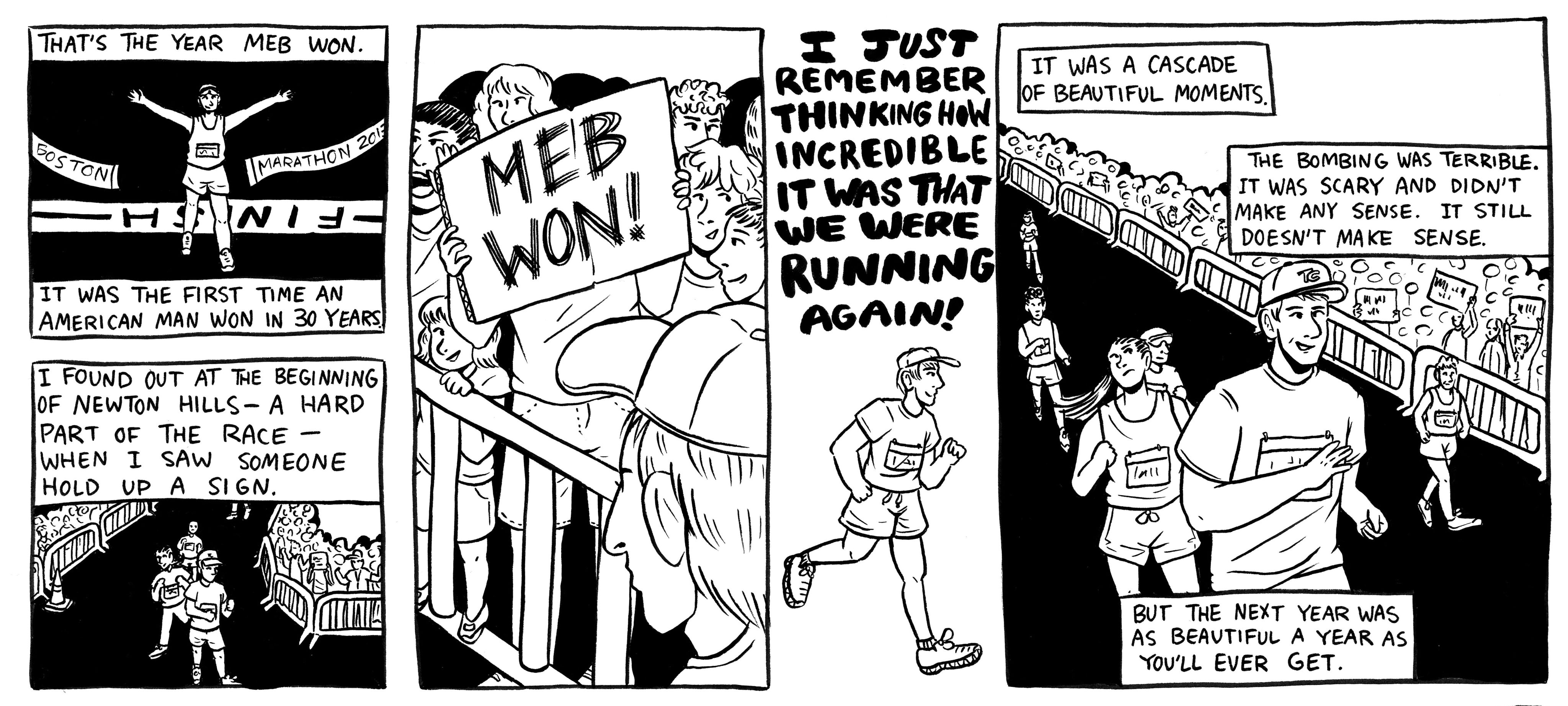
An excerpt from student Teddie Bernard's comics oral history of the Boston Marathon, as told by their dad.
An excerpt from student Teddie Bernard's comics oral history of the Boston Marathon, as told by their dad.
by Megan Kirby
“On Saturday, October 13th, I went to the March to the Polls rally in Grant Park with my sketchbook under my arm,” begins Lecturer Anya Davidson’s comics journalism feature “Raised Voices,” published in the Chicago Reader. On that fall day in 2018, Davidson interviewed protesters about what brought them out to the march. Though she had years of experience in comics—including several published books, zines, and webcomics—that assignment introduced her to comics journalism. Her first-person interviews and colorful panels distilled a busy and complicated day into two accessible pages. “Comics are essentially like a universal language,” she said. “They’re about ease of communication, clarity of communication.”
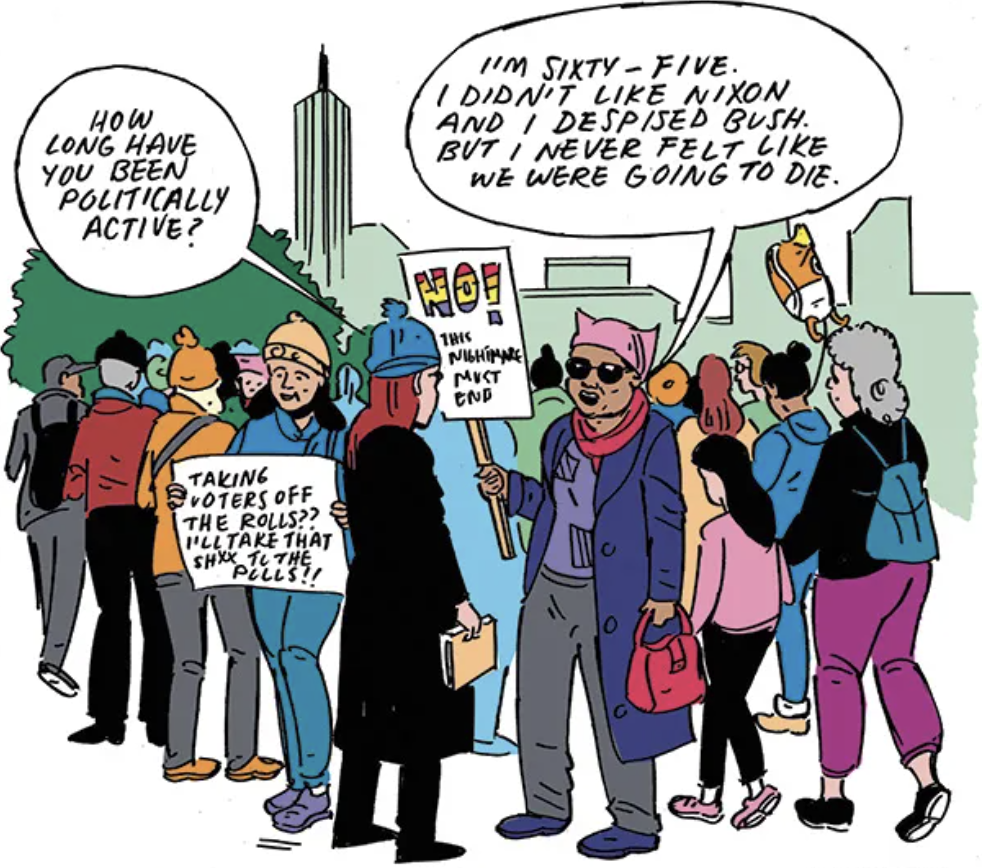
A panel from Anya Davidson's "Raised Voices" piece for the Chicago Reader.
A panel from Anya Davidson's "Raised Voices" piece for the Chicago Reader.
From then on, Davidson obsessed over combining the research and ethics of journalism with the accessibility of comics. In 2020, the undergraduate class Comics: Graphic Journalism was born. The class tackles two things: the fundamentals of graphic storytelling and the tenets of quality journalism. Through the semester, students receive the tools they need to tell nonfiction stories in a comics format.
Different assignments approach different aspects of both journalism and illustration. The first assignment is an oral history, where students interview someone they know and create a comic from that conversation. Student Teddie Bernard interviewed their dad about running in the 2013 Boston Marathon, when a terrorist attack killed three people and injured 264 more. Turning an hour-long interview into a two-page comic came with distinct challenges. Bernard narrowed down the transcript and created thumbnails to capture the core story. They referenced photos of marathon runners and crowd shots to figure out their composition. And when they honed everything down to the heart of the story, they were surprised. “It ended up being this kind of beautiful story about Boston [the following year],” they said. “The way that the community came together and really uplifted the runners and did all of this amazing work to move past the tragedy.”
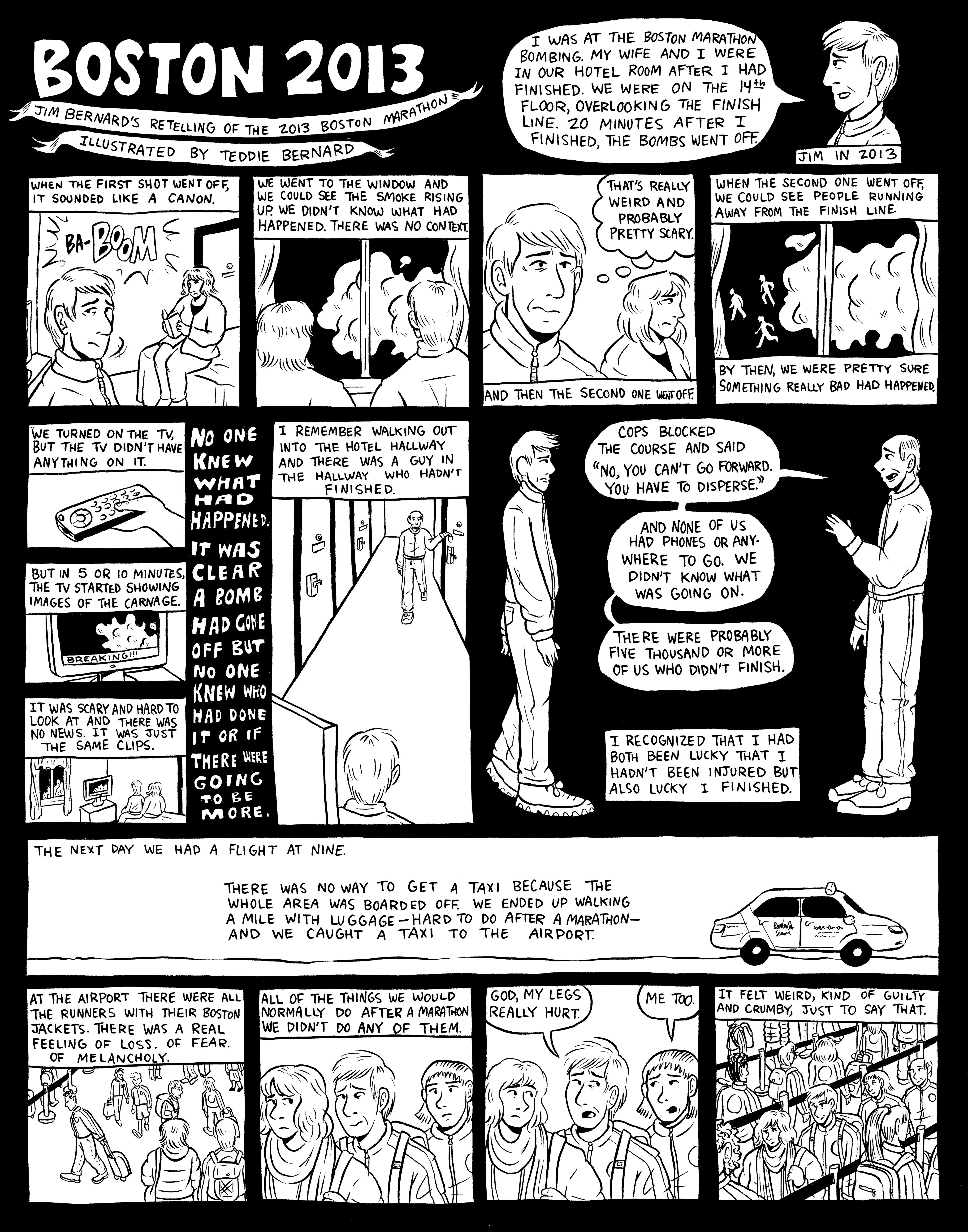
The first page of student Teddie Bernard's comics oral history about the Boston Marathon.
The first page of student Teddie Bernard's comics oral history about the Boston Marathon.
From that first assignment, students create editorial comics, arts and culture reviews, and explainer comics, collecting the building blocks of graphic storytelling along the way. “Those short assignments get everyone up to speed, because in addition to covering all those concepts in journalism, we’re also covering how-to cartooning basics,” Davidson said.
Throughout the class, students pursue wide-ranging subjects. One student took a walking tour of Pilsen and explored the pros and cons of designating historic landmarks. Another chronicled the rise of OnWord Skate Collective, a group working to make skateparks more accessible to women, queer people, and other nontraditional skaters. Over the semester, students learn how to navigate the media landscape to find reliable sources, verify facts, and work all of those details into their storytelling.
Because comics journalism is a relatively new field, little scholarly writing exists on the subject. One of the earliest and most famous examples of proto-comics journalism is Art Spiegelman’s Maus, a two-volume graphic novel following the Spiegelman family’s experience during the Holocaust. Today, traditional publications like The New Yorker dabble in graphic journalism and memoir. More graphic memoirs, histories, and biographies come out every year. The website The Nib even specializes in nonfiction comics.
In building the syllabus, Davidson knew how to teach comics basics. But the journalism side was new to her. She took online courses from the Poynter Institute, a non-profit journalism school in St. Petersburg, Florida. She explored local journalism nonprofits like City Bureau and Block Club Chicago. “I took resources from places like that and interweaved them with materials about the theory and practice of cartooning,” she said.
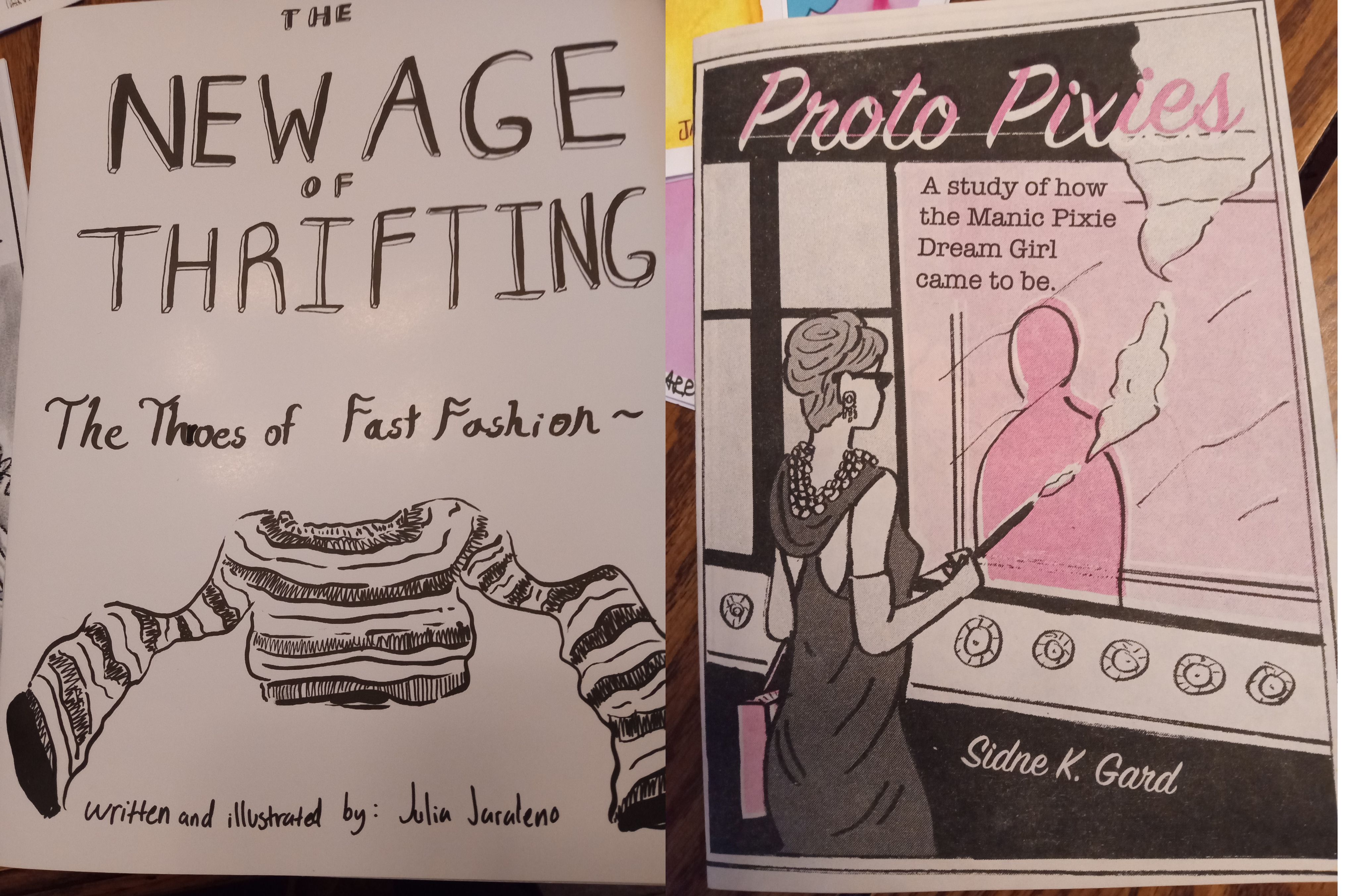
Final projects are printed as zines, like Julia Jaraleno's The New Age of Thrifting and Sidne K. Gard's Proto Pixies: A Study of How the Manic Pixie Dream Girl Came to Be.
Final projects are printed as zines, like Julia Jaraleno's The New Age of Thrifting and Sidne K. Gard's Proto Pixies: A Study of How the Manic Pixie Dream Girl Came to Be.
For their final projects, students print long-form feature comics in zines. They research primary and secondary sources, pitch the project to the class, and learn the basics of InDesign layouts. The subject matter is entirely up to the authors. Sidne K. Gard self-published Proto Pixies: A Study of How the Manic Pixie Dream Girl Came to Be. Julia Jaraleno dove into fashion’s ecological impact with The New Age of Thrifting: The Throes of Fast Fashion. At the end of the semester, the students exchange their finished zines.
The labor that goes into researching and drawing a long-form comic can be intense, but it also lets authors slow down and really examine their subject matter. “Typically, the types of stories you’re telling with comics journalism are not breaking news stories,” Davidson said. “They’re stories where you’re getting a really in-depth look rather than what’s flashing by in a 24-hour news cycle.”
The class introduces many students to graphic journalism—and some find that they want to explore the craft further. After the semester, Bernard kept up with comics, and they stepped up as the comics editor for F Newsmagazine. “I love graphic journalism,” they said. “It’s a super accessible way to share information and news in a way that news writing—while it’s not inaccessible—can be harder to get people interested in.”
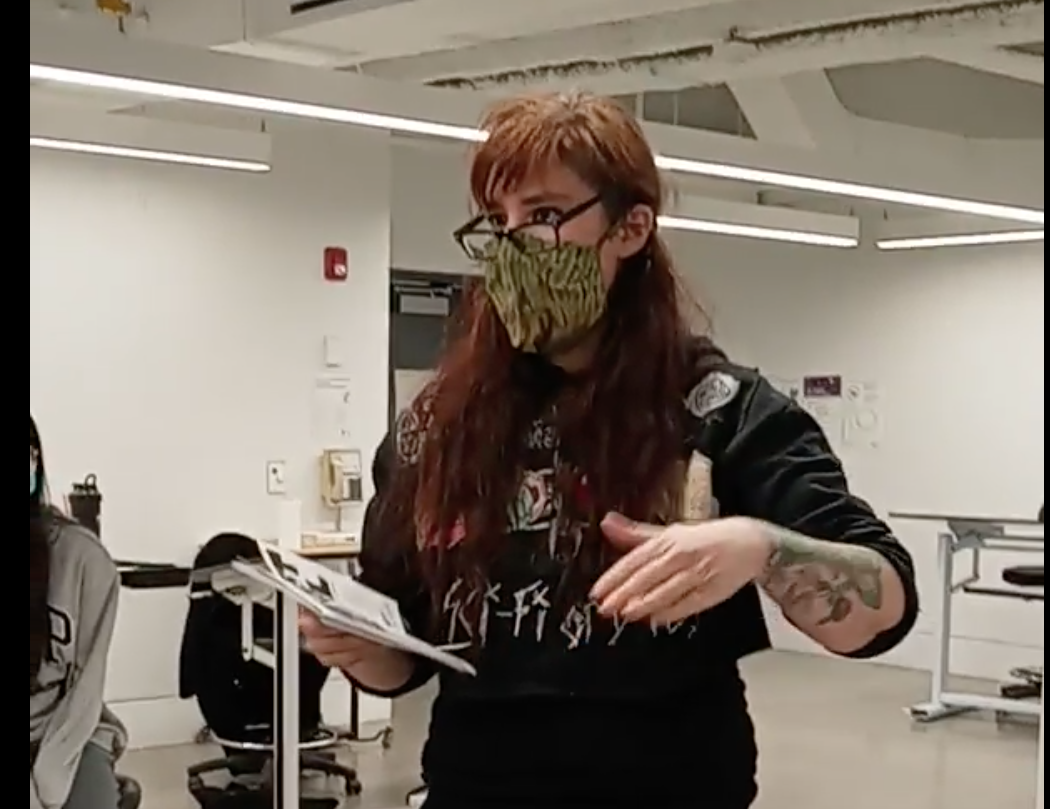
Davidson leads a Comics: Graphic Journalism class in a discussion.
Davidson leads a Comics: Graphic Journalism class in a discussion.
In the years since she jumped into comics journalism, Davidson has seen the medium flourish. “Taking complex information and making it easy to understand is a great skill, and it’s really in demand right now,” she said. “People feel so overwhelmed. [Media] can be difficult to interpret. We can read these little pictograms. Our brains are hardwired to understand comics.”■
{{[http://www.saic.edu/news/facultystaff]FACULTY & STAFF}}
